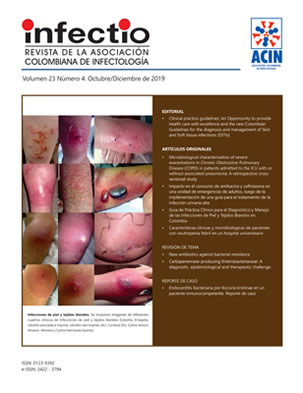Carbapenemase-producing Enterobacteriaceae: A diagnostic, epidemiological and therapeutic challenge
Contenido principal del artículo
Resumen
The global spread of carbapenemase-producing Enterobacteriaceae (CPE) has become a public health problem. Not all CPE are resistant to carbapenems creating a diagnostic and therapeutic challenge. Furthermore, as resistance to carbapenems can also be mediated by other ?-lactamases combined with defects in membrane permeability, their detection can be difficult by microbiology laboratories that lack molecular tools, which may limit and often delay the correct antibiotic selection.
There is only limited evidence regarding infection control measures to contain the spread of CPE. However, recomendations have been published from the World Health Organization (WHO) and the European Prevention Center and Disease Control (ECDC). Because of the lack of randomized control trials, treatment regimens are mostly based on observational clinical studies. Several of those studies have reported that combination therapy with two or more in vitro-active agents including a carbapenem is superior to monotherapy. On the other hand, a new ?-lactamase inhibitor in combination with ceftazidime has shown clinical efficacy Against KPC and some OXA-type producing Enterobacteriaceae.

